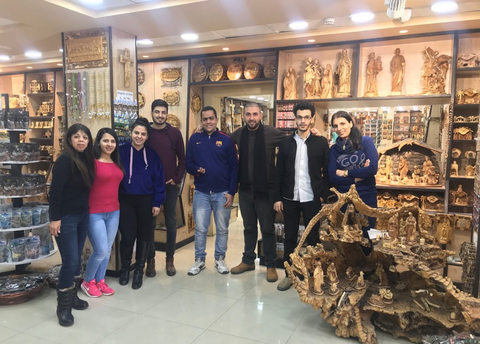
Introduction to Olive Wood Carvings Have you ever held a piece of history in your hands? Olive wood carvings from Bethlehem are not just souvenirs; they are narratives carved into wood, each with a story to tell. Let's delve into the rich tapestry of history that surrounds these unique artifacts.
The Roots of Bethlehem's Olive Wood Craft Bethlehem, a name that resonates with historical and spiritual significance, is also the cradle of an ancient craft. For centuries, the artisans of this holy city have turned the gnarled branches of olive trees into objects of beauty and devotion.
Why Olive Wood? Olive trees are more than just plants in Bethlehem; they are symbols of endurance and peace. Their wood is dense, durable, and has a distinctive warm grain that makes it ideal for carving. But why do these trees, which take decades to mature, hold such a revered place in the hearts of carvers?

Historical Significance The history of olive wood carvings is as old as the city itself. These carvings are not just art; they are a testament to Bethlehem's enduring spirit.
Biblical Connections It's said that the olive trees in Bethlehem have witnessed the dawn of Christianity. The Bible is replete with references to olives, making these carvings deeply rooted in faith and tradition.
From Ancient to Modern Times The tradition has evolved, but the essence remains unchanged. Today, olive wood carvings are a fusion of ancient skill and contemporary design, making them popular worldwide.
The Artisans Behind the Craft Behind every carving is an artisan with a story. These craftsmen are the keepers of an age-old tradition, each piece a reflection of their dedication.
Mastering the Art Becoming a master carver takes years of practice. It's an art that demands patience, precision, and a deep understanding of the material.
Family Traditions and Trade Secrets Many carving techniques are family heirlooms, passed down through generations. These secrets are the soul of Bethlehem's olive wood craft.
The Carving Process The journey from tree to treasure is a fascinating one. Let's walk through the steps that transform a simple branch into a work of art.
Selecting the Wood The process begins with the selection of the perfect piece of wood. Each piece is chosen for its potential to become something extraordinary.
Tools of the Trade From chisels to sandpaper, the tools used by Bethlehem's carvers are as varied as the carvings themselves. Each tool plays a crucial role in the creation process.
From Rough Cut to Refined Art The transformation from a rough block of wood to a polished sculpture is a sight to behold. It's a process that can take weeks, even months, to complete.
Symbolism in Olive Wood Carvings Each carving is more than just a decorative piece; it's a symbol, a story, a piece of Bethlehem itself.
Religious Motifs From nativity scenes to crosses, the religious motifs in these carvings are powerful symbols of faith.

Cultural Significance But it's not just about religion. These carvings also reflect the rich culture and history of the Palestinian people.
The Evolution of the Craft As the world changes, so too does the craft of olive wood carving. Let's explore how this ancient art is adapting to the modern world.
Innovations in Carving Technology and new design trends are bringing fresh perspectives to this traditional craft, ensuring its place in the future.
The Global Market and Bethlehem Carvings Bethlehem's carvings have found their way into homes around the world, each piece an ambassador of Palestinian craftsmanship.
Challenges Facing the Olive Wood Industry Despite its popularity, the olive wood carving industry faces significant challenges.
Environmental Concerns The very trees that supply the wood are under threat. How are carvers and conservationists working together to protect these ancient groves?
Economic Hurdles Political instability and economic barriers also pose challenges to the artisans of Bethlehem. What does the future hold for them?
Preserving the Tradition In the face of these challenges, there's a concerted effort to keep the tradition alive.
Role of Local Communities Local communities are at the heart of the preservation effort, with initiatives aimed at sustaining both the craft and the environment.
International Support And it's not just a local effort; international support plays a vital role in keeping this ancient art form thriving.
Conclusion Olive wood carvings from Bethlehem are more than just beautiful objects; they are a living link to the past, a symbol of hope and resilience. As we admire these intricate works of art, let's remember the hands that carved them and the history they carry.


